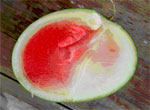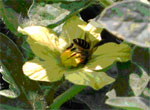Watermelons require insects for proper pollination and fruit growth. Research has shown that each female flower must be visited, on average, seven times by a pollinating insect to ensure proper fruit set. Insufficient pollination results in misshapen melons, which must be culled (Figure 2).

Figure 2. Immature watermelon. Poor shape is due to insufficient pollination
Individually, honeybees (Figure 3) are not as efficient at pollinating as wild bees, but their large numbers make them very good at ensuring proper pollination. If an insufficient number of pollinators are present, supplement them with domestic hives.

Figure 3. A honeybee visiting a female flower
Common insect pollinators for watermelon are honeybee (Apis cerana), locally known as lebah; asiatic honeybee ( Apis dorsata ), locally known as lebah rimba/tualang/ chamor; stingless bee ( Trigona thoracica, Trigona sp. ) and ants. Bees forage on cucurbit flowers for nectar, the bee's energy source, and pollen, their source of protein, vitamins, minerals, and lipids. Collection of pollen by bees usually ends before noon, but nectar collection continues into late afternoon.
In commercial watermelon production, seeded watermelon is used as source of pollen to pollinate seedless watermelon to produce good fruit. They are normally grown in alternate rows. High fruit set comes from pollination ocurring between 9 am and 10 am. Inadequate pollination will result in mishapen, undersized and low quality fruit.
In a large farm where enough wild bees are not available, growers sometimes carry out assisted pollination on seedless watermelon, where pollen from male flowers of seeded watermelons are carefully spread (rubbbed) on the stigma of female flowers of seedless watermelon. Good yields can be expected if all three parts of the stigma receive sufficient pollen.
Recent studies by MARDI indicate that assisted pollination is not necessary if beehive colonies are placed in the watermelon farm.
Apply pesticides when bee activity is low to minimise impact. This will occur late in the day, around dusk, and on overcast days. Check pesticide labels for additional precautions concerning bees. |

